[PDF] Advanced Financial Accounting Assignment
VerifiedAdded on 2021/05/30
|15
|3606
|24
AI Summary
Contribute Materials
Your contribution can guide someone’s learning journey. Share your
documents today.
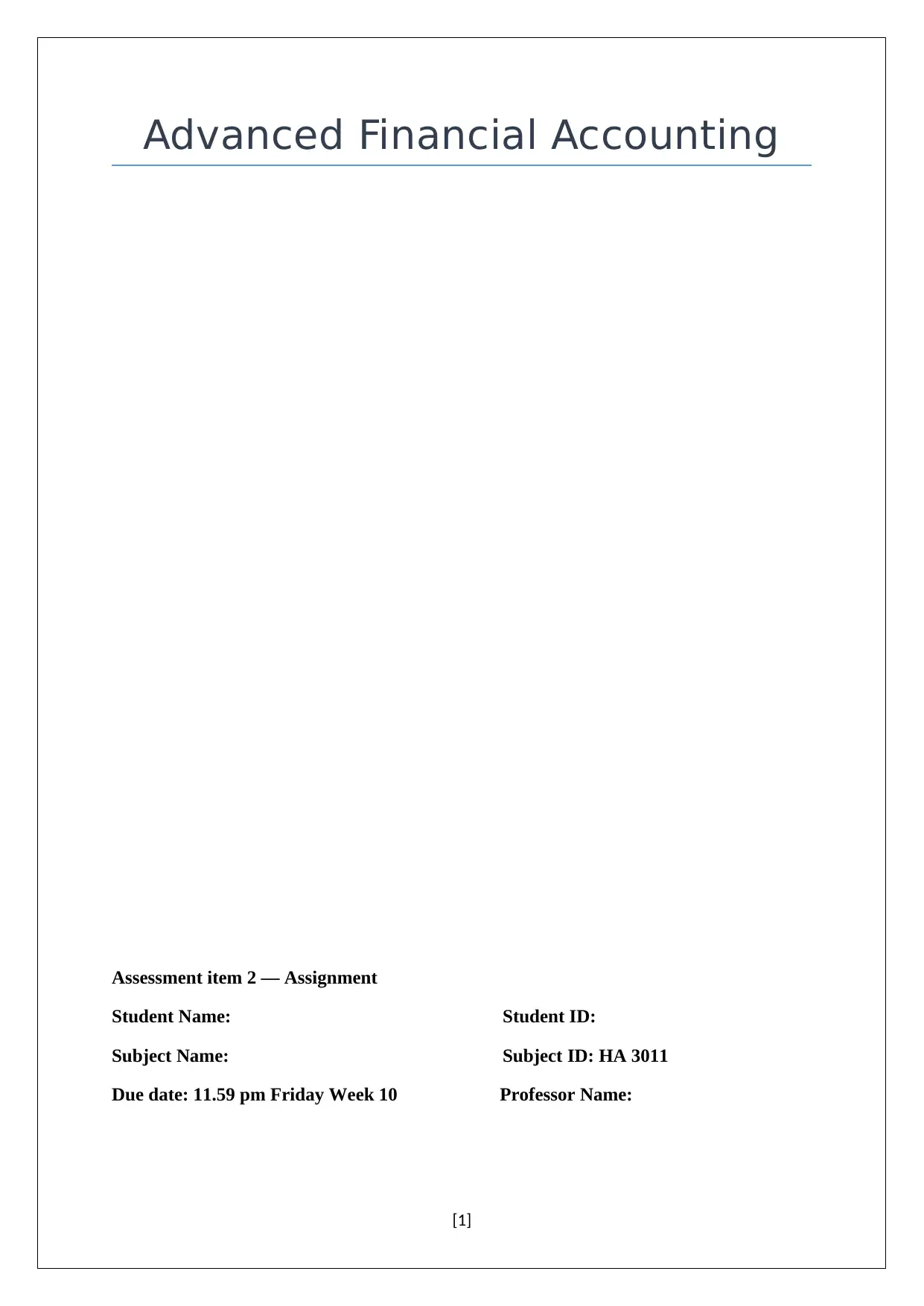
Advanced Financial Accounting
Assessment item 2 — Assignment
Student Name: Student ID:
Subject Name: Subject ID: HA 3011
Due date: 11.59 pm Friday Week 10 Professor Name:
[1]
Assessment item 2 — Assignment
Student Name: Student ID:
Subject Name: Subject ID: HA 3011
Due date: 11.59 pm Friday Week 10 Professor Name:
[1]
Secure Best Marks with AI Grader
Need help grading? Try our AI Grader for instant feedback on your assignments.
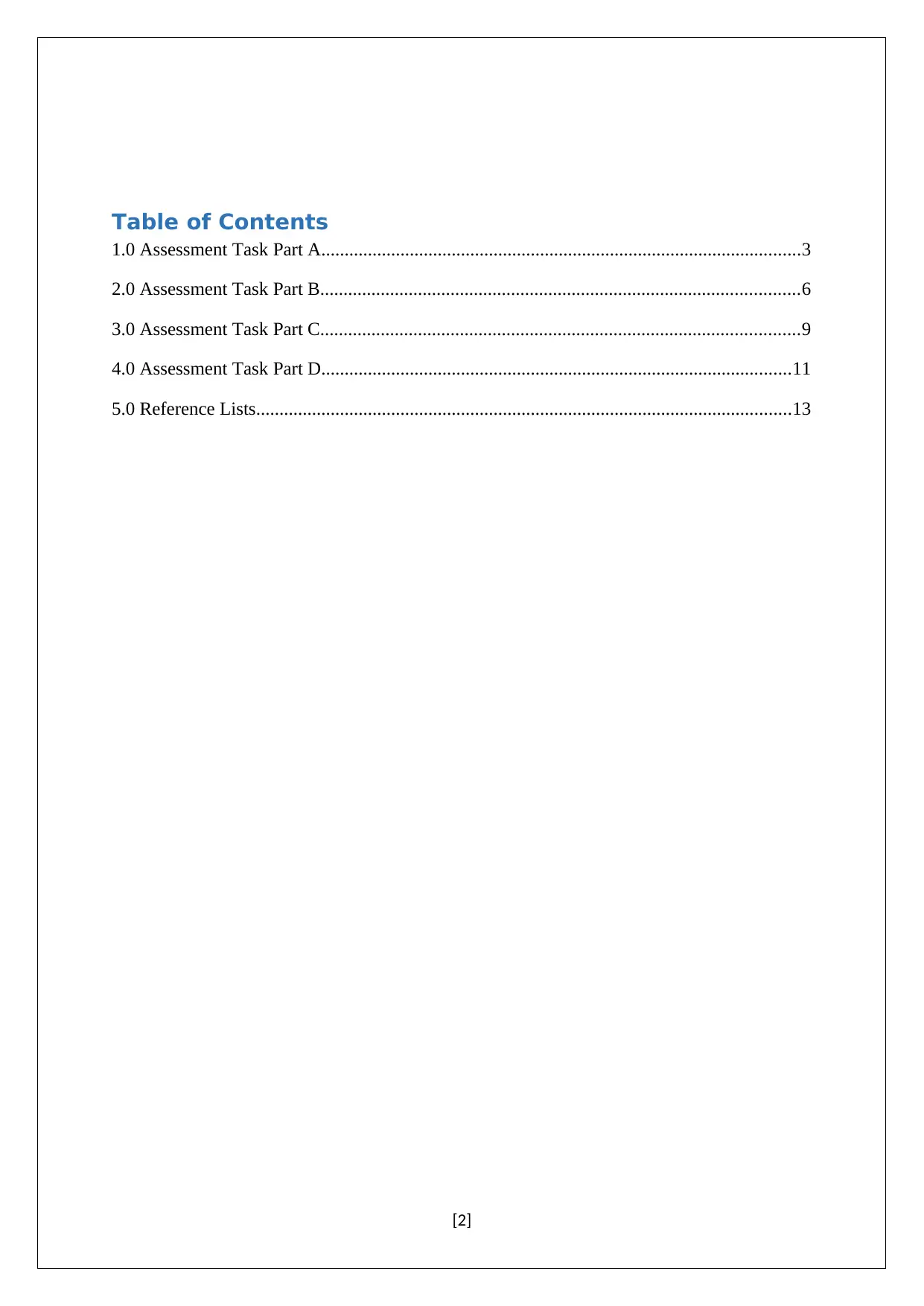
Table of Contents
1.0 Assessment Task Part A.......................................................................................................3
2.0 Assessment Task Part B.......................................................................................................6
3.0 Assessment Task Part C.......................................................................................................9
4.0 Assessment Task Part D.....................................................................................................11
5.0 Reference Lists...................................................................................................................13
[2]
1.0 Assessment Task Part A.......................................................................................................3
2.0 Assessment Task Part B.......................................................................................................6
3.0 Assessment Task Part C.......................................................................................................9
4.0 Assessment Task Part D.....................................................................................................11
5.0 Reference Lists...................................................................................................................13
[2]

1.0 Assessment Task Part A
The Framework's goal is to accommodate IASB towards developing and reconsidering IFRS
which further includes steady ideas, for preparing to develop reliable bookkeeping
arrangements varied regions (Schroeder, Clark & Cathey, 2011). The sole purpose is to cater
to places which does not encompasses standard or where there arises decision of accounting
policy, for the purpose of all gatherings to assimilate and translate IFRS. Without prevalence
of Standards that can particularly apply to a transaction, administration must utilize its
judgment in creating and applying accounting policies that provide adequate reliable
information. In order to arrive at a decision making, IAS 8.11 provides that the administration
need to consider various definitions, acknowledgment criteria, and estimation ideas for assets,
liabilities, incomes and expenses according to the Framework. This aspect was added to the
Framework in the 2003 while making amendments to IAS 8. The Conceptual Framework
does not abrogate a particular IFRS. In case the IASB chooses to issue another or
reconsidered proclamation that is not in accordance with the Framework. The IASB must
feature the reality and clarify the explanations behind the reason for conclusions.
The qualitative attributes of financial reporting reviews varied types of data which
probabilistically going to be appreciated to clients. Thus, in settling on choices about the
reporting entities based on data in financial report various data and information needs to be
considered. The subjective characteristics apply similarly to financial data in every financial
report and additionally to financial data in different ways (Cotter, 2012). Financial data is
helpful when it is applicable and provides details that it is supposed to represent. The
financial data usefulness is upgraded in case it can be practically identical, undeniable,
convenient and justifiable. Qualitative characteristics are generally pertinent and dependable
portrayal is the crucial subjective qualities of valuable financial information.
[3]
The Framework's goal is to accommodate IASB towards developing and reconsidering IFRS
which further includes steady ideas, for preparing to develop reliable bookkeeping
arrangements varied regions (Schroeder, Clark & Cathey, 2011). The sole purpose is to cater
to places which does not encompasses standard or where there arises decision of accounting
policy, for the purpose of all gatherings to assimilate and translate IFRS. Without prevalence
of Standards that can particularly apply to a transaction, administration must utilize its
judgment in creating and applying accounting policies that provide adequate reliable
information. In order to arrive at a decision making, IAS 8.11 provides that the administration
need to consider various definitions, acknowledgment criteria, and estimation ideas for assets,
liabilities, incomes and expenses according to the Framework. This aspect was added to the
Framework in the 2003 while making amendments to IAS 8. The Conceptual Framework
does not abrogate a particular IFRS. In case the IASB chooses to issue another or
reconsidered proclamation that is not in accordance with the Framework. The IASB must
feature the reality and clarify the explanations behind the reason for conclusions.
The qualitative attributes of financial reporting reviews varied types of data which
probabilistically going to be appreciated to clients. Thus, in settling on choices about the
reporting entities based on data in financial report various data and information needs to be
considered. The subjective characteristics apply similarly to financial data in every financial
report and additionally to financial data in different ways (Cotter, 2012). Financial data is
helpful when it is applicable and provides details that it is supposed to represent. The
financial data usefulness is upgraded in case it can be practically identical, undeniable,
convenient and justifiable. Qualitative characteristics are generally pertinent and dependable
portrayal is the crucial subjective qualities of valuable financial information.
[3]
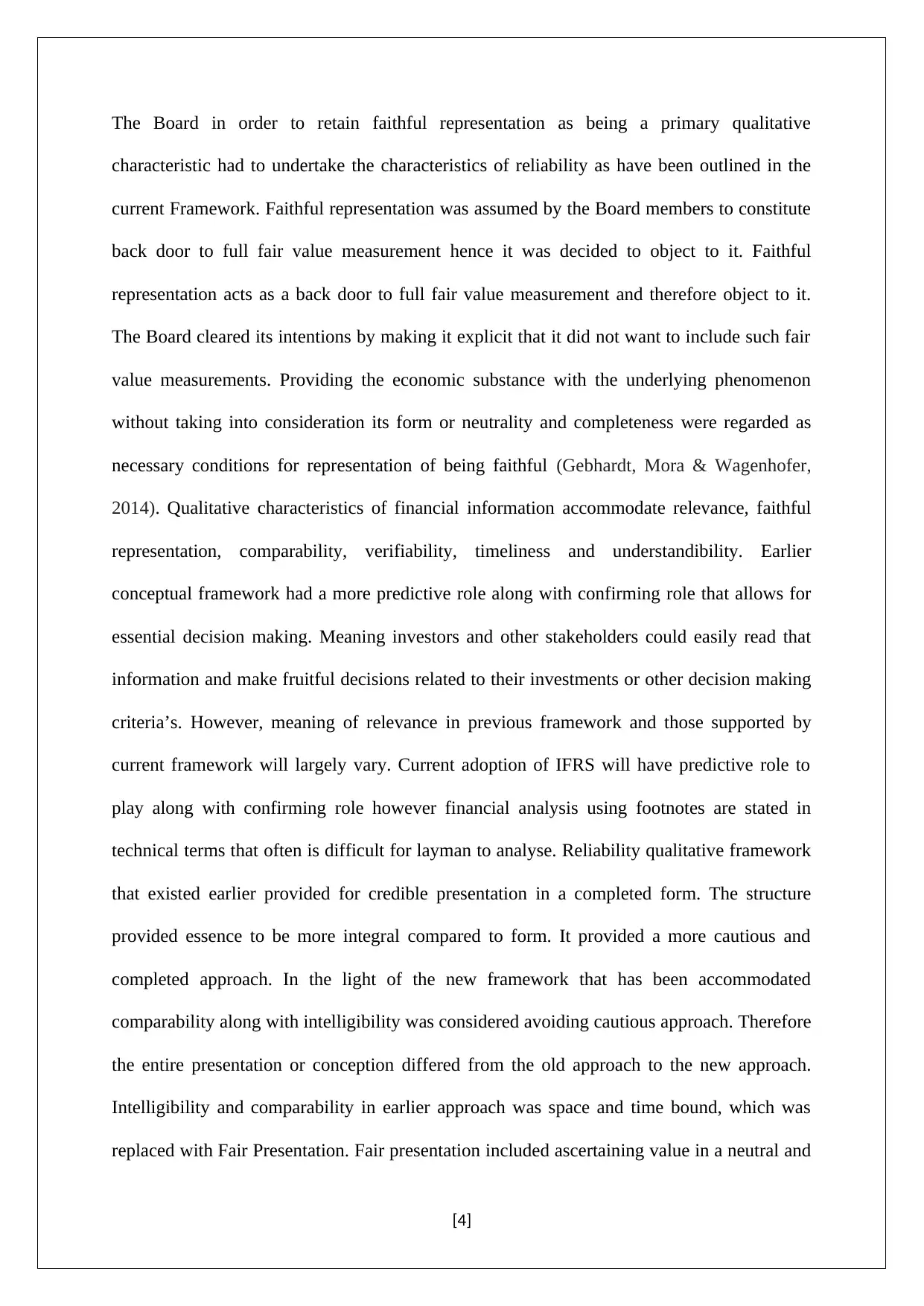
The Board in order to retain faithful representation as being a primary qualitative
characteristic had to undertake the characteristics of reliability as have been outlined in the
current Framework. Faithful representation was assumed by the Board members to constitute
back door to full fair value measurement hence it was decided to object to it. Faithful
representation acts as a back door to full fair value measurement and therefore object to it.
The Board cleared its intentions by making it explicit that it did not want to include such fair
value measurements. Providing the economic substance with the underlying phenomenon
without taking into consideration its form or neutrality and completeness were regarded as
necessary conditions for representation of being faithful (Gebhardt, Mora & Wagenhofer,
2014). Qualitative characteristics of financial information accommodate relevance, faithful
representation, comparability, verifiability, timeliness and understandibility. Earlier
conceptual framework had a more predictive role along with confirming role that allows for
essential decision making. Meaning investors and other stakeholders could easily read that
information and make fruitful decisions related to their investments or other decision making
criteria’s. However, meaning of relevance in previous framework and those supported by
current framework will largely vary. Current adoption of IFRS will have predictive role to
play along with confirming role however financial analysis using footnotes are stated in
technical terms that often is difficult for layman to analyse. Reliability qualitative framework
that existed earlier provided for credible presentation in a completed form. The structure
provided essence to be more integral compared to form. It provided a more cautious and
completed approach. In the light of the new framework that has been accommodated
comparability along with intelligibility was considered avoiding cautious approach. Therefore
the entire presentation or conception differed from the old approach to the new approach.
Intelligibility and comparability in earlier approach was space and time bound, which was
replaced with Fair Presentation. Fair presentation included ascertaining value in a neutral and
[4]
characteristic had to undertake the characteristics of reliability as have been outlined in the
current Framework. Faithful representation was assumed by the Board members to constitute
back door to full fair value measurement hence it was decided to object to it. Faithful
representation acts as a back door to full fair value measurement and therefore object to it.
The Board cleared its intentions by making it explicit that it did not want to include such fair
value measurements. Providing the economic substance with the underlying phenomenon
without taking into consideration its form or neutrality and completeness were regarded as
necessary conditions for representation of being faithful (Gebhardt, Mora & Wagenhofer,
2014). Qualitative characteristics of financial information accommodate relevance, faithful
representation, comparability, verifiability, timeliness and understandibility. Earlier
conceptual framework had a more predictive role along with confirming role that allows for
essential decision making. Meaning investors and other stakeholders could easily read that
information and make fruitful decisions related to their investments or other decision making
criteria’s. However, meaning of relevance in previous framework and those supported by
current framework will largely vary. Current adoption of IFRS will have predictive role to
play along with confirming role however financial analysis using footnotes are stated in
technical terms that often is difficult for layman to analyse. Reliability qualitative framework
that existed earlier provided for credible presentation in a completed form. The structure
provided essence to be more integral compared to form. It provided a more cautious and
completed approach. In the light of the new framework that has been accommodated
comparability along with intelligibility was considered avoiding cautious approach. Therefore
the entire presentation or conception differed from the old approach to the new approach.
Intelligibility and comparability in earlier approach was space and time bound, which was
replaced with Fair Presentation. Fair presentation included ascertaining value in a neutral and
[4]
Secure Best Marks with AI Grader
Need help grading? Try our AI Grader for instant feedback on your assignments.
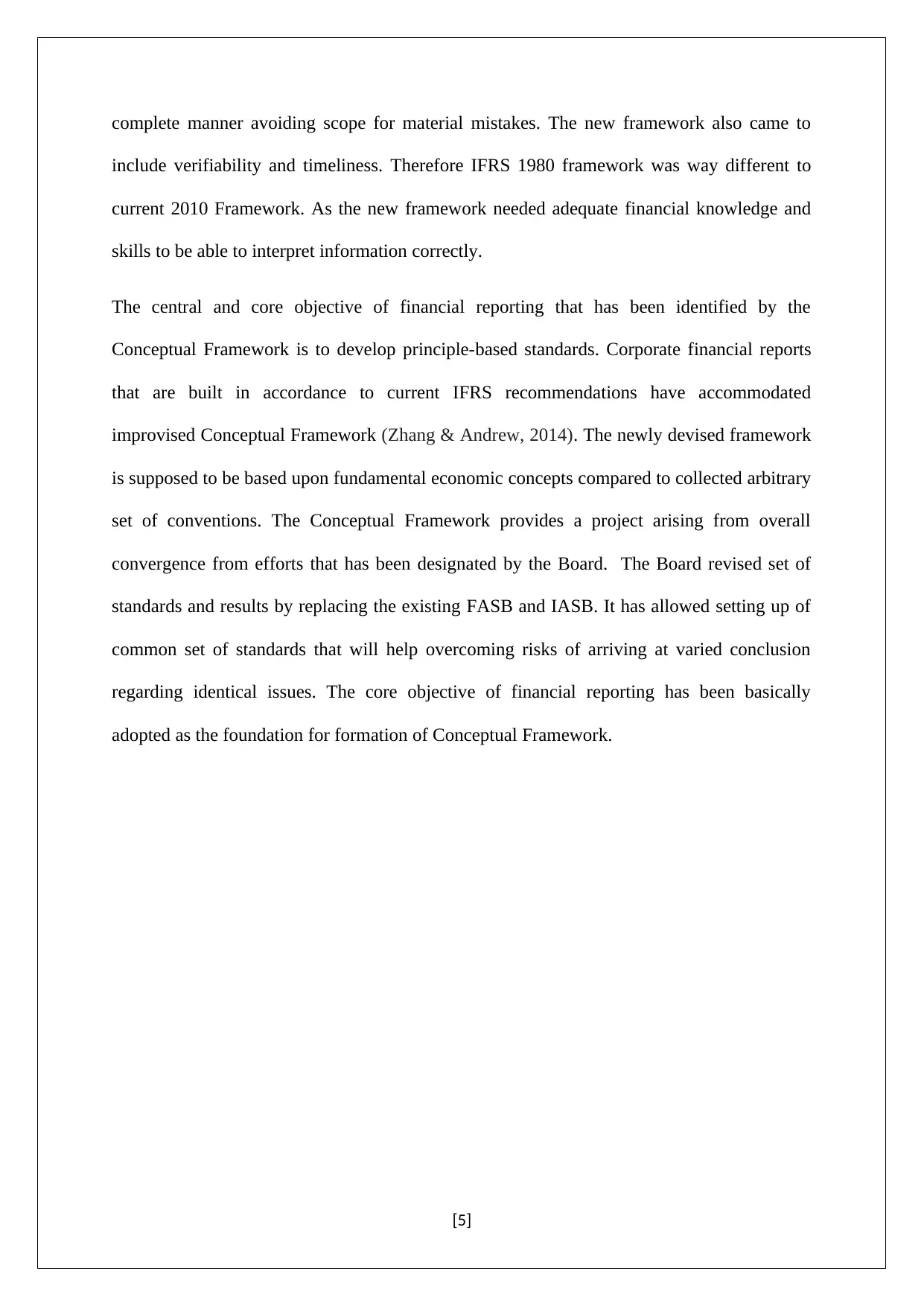
complete manner avoiding scope for material mistakes. The new framework also came to
include verifiability and timeliness. Therefore IFRS 1980 framework was way different to
current 2010 Framework. As the new framework needed adequate financial knowledge and
skills to be able to interpret information correctly.
The central and core objective of financial reporting that has been identified by the
Conceptual Framework is to develop principle-based standards. Corporate financial reports
that are built in accordance to current IFRS recommendations have accommodated
improvised Conceptual Framework (Zhang & Andrew, 2014). The newly devised framework
is supposed to be based upon fundamental economic concepts compared to collected arbitrary
set of conventions. The Conceptual Framework provides a project arising from overall
convergence from efforts that has been designated by the Board. The Board revised set of
standards and results by replacing the existing FASB and IASB. It has allowed setting up of
common set of standards that will help overcoming risks of arriving at varied conclusion
regarding identical issues. The core objective of financial reporting has been basically
adopted as the foundation for formation of Conceptual Framework.
[5]
include verifiability and timeliness. Therefore IFRS 1980 framework was way different to
current 2010 Framework. As the new framework needed adequate financial knowledge and
skills to be able to interpret information correctly.
The central and core objective of financial reporting that has been identified by the
Conceptual Framework is to develop principle-based standards. Corporate financial reports
that are built in accordance to current IFRS recommendations have accommodated
improvised Conceptual Framework (Zhang & Andrew, 2014). The newly devised framework
is supposed to be based upon fundamental economic concepts compared to collected arbitrary
set of conventions. The Conceptual Framework provides a project arising from overall
convergence from efforts that has been designated by the Board. The Board revised set of
standards and results by replacing the existing FASB and IASB. It has allowed setting up of
common set of standards that will help overcoming risks of arriving at varied conclusion
regarding identical issues. The core objective of financial reporting has been basically
adopted as the foundation for formation of Conceptual Framework.
[5]
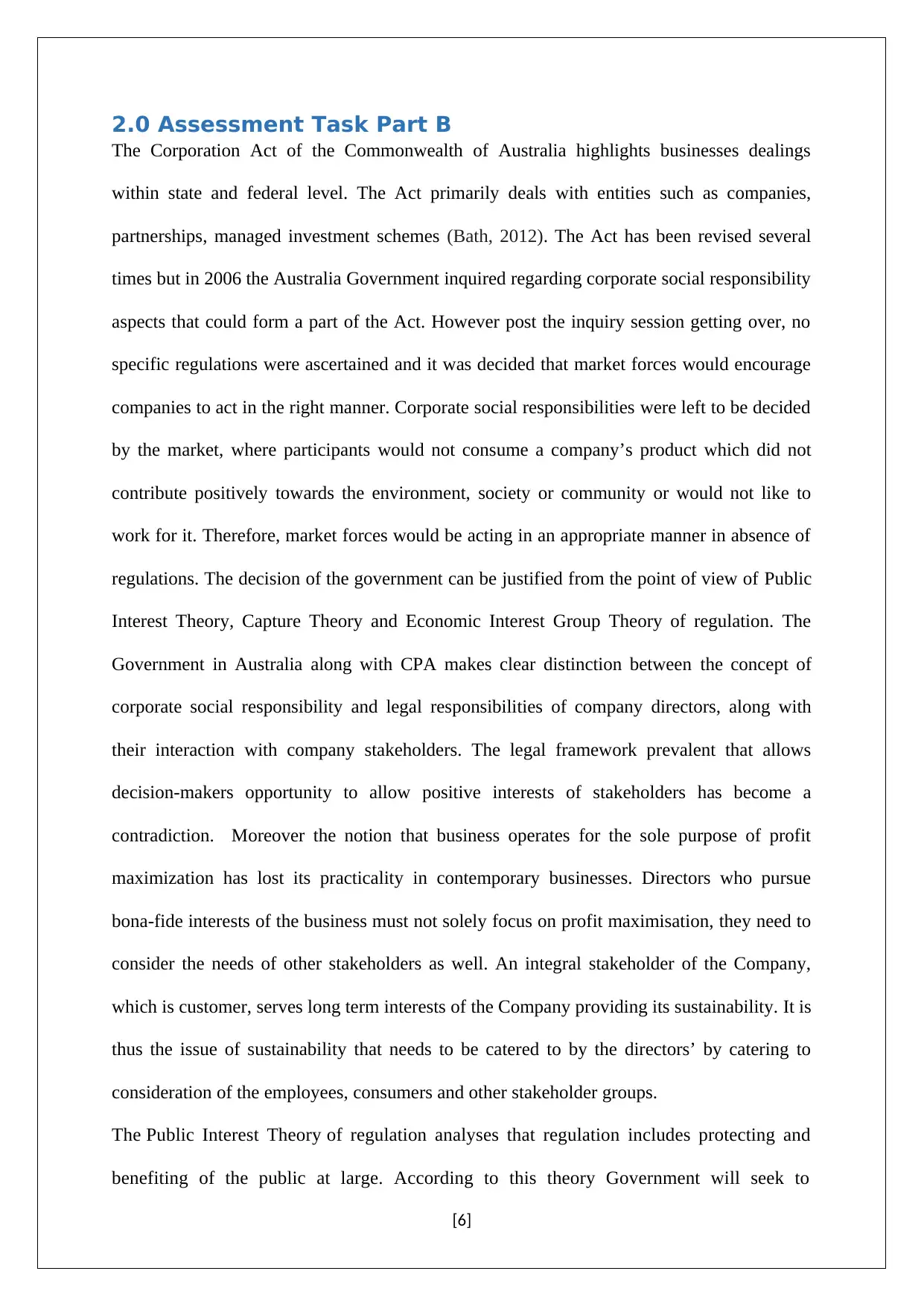
2.0 Assessment Task Part B
The Corporation Act of the Commonwealth of Australia highlights businesses dealings
within state and federal level. The Act primarily deals with entities such as companies,
partnerships, managed investment schemes (Bath, 2012). The Act has been revised several
times but in 2006 the Australia Government inquired regarding corporate social responsibility
aspects that could form a part of the Act. However post the inquiry session getting over, no
specific regulations were ascertained and it was decided that market forces would encourage
companies to act in the right manner. Corporate social responsibilities were left to be decided
by the market, where participants would not consume a company’s product which did not
contribute positively towards the environment, society or community or would not like to
work for it. Therefore, market forces would be acting in an appropriate manner in absence of
regulations. The decision of the government can be justified from the point of view of Public
Interest Theory, Capture Theory and Economic Interest Group Theory of regulation. The
Government in Australia along with CPA makes clear distinction between the concept of
corporate social responsibility and legal responsibilities of company directors, along with
their interaction with company stakeholders. The legal framework prevalent that allows
decision-makers opportunity to allow positive interests of stakeholders has become a
contradiction. Moreover the notion that business operates for the sole purpose of profit
maximization has lost its practicality in contemporary businesses. Directors who pursue
bona-fide interests of the business must not solely focus on profit maximisation, they need to
consider the needs of other stakeholders as well. An integral stakeholder of the Company,
which is customer, serves long term interests of the Company providing its sustainability. It is
thus the issue of sustainability that needs to be catered to by the directors’ by catering to
consideration of the employees, consumers and other stakeholder groups.
The Public Interest Theory of regulation analyses that regulation includes protecting and
benefiting of the public at large. According to this theory Government will seek to
[6]
The Corporation Act of the Commonwealth of Australia highlights businesses dealings
within state and federal level. The Act primarily deals with entities such as companies,
partnerships, managed investment schemes (Bath, 2012). The Act has been revised several
times but in 2006 the Australia Government inquired regarding corporate social responsibility
aspects that could form a part of the Act. However post the inquiry session getting over, no
specific regulations were ascertained and it was decided that market forces would encourage
companies to act in the right manner. Corporate social responsibilities were left to be decided
by the market, where participants would not consume a company’s product which did not
contribute positively towards the environment, society or community or would not like to
work for it. Therefore, market forces would be acting in an appropriate manner in absence of
regulations. The decision of the government can be justified from the point of view of Public
Interest Theory, Capture Theory and Economic Interest Group Theory of regulation. The
Government in Australia along with CPA makes clear distinction between the concept of
corporate social responsibility and legal responsibilities of company directors, along with
their interaction with company stakeholders. The legal framework prevalent that allows
decision-makers opportunity to allow positive interests of stakeholders has become a
contradiction. Moreover the notion that business operates for the sole purpose of profit
maximization has lost its practicality in contemporary businesses. Directors who pursue
bona-fide interests of the business must not solely focus on profit maximisation, they need to
consider the needs of other stakeholders as well. An integral stakeholder of the Company,
which is customer, serves long term interests of the Company providing its sustainability. It is
thus the issue of sustainability that needs to be catered to by the directors’ by catering to
consideration of the employees, consumers and other stakeholder groups.
The Public Interest Theory of regulation analyses that regulation includes protecting and
benefiting of the public at large. According to this theory Government will seek to
[6]
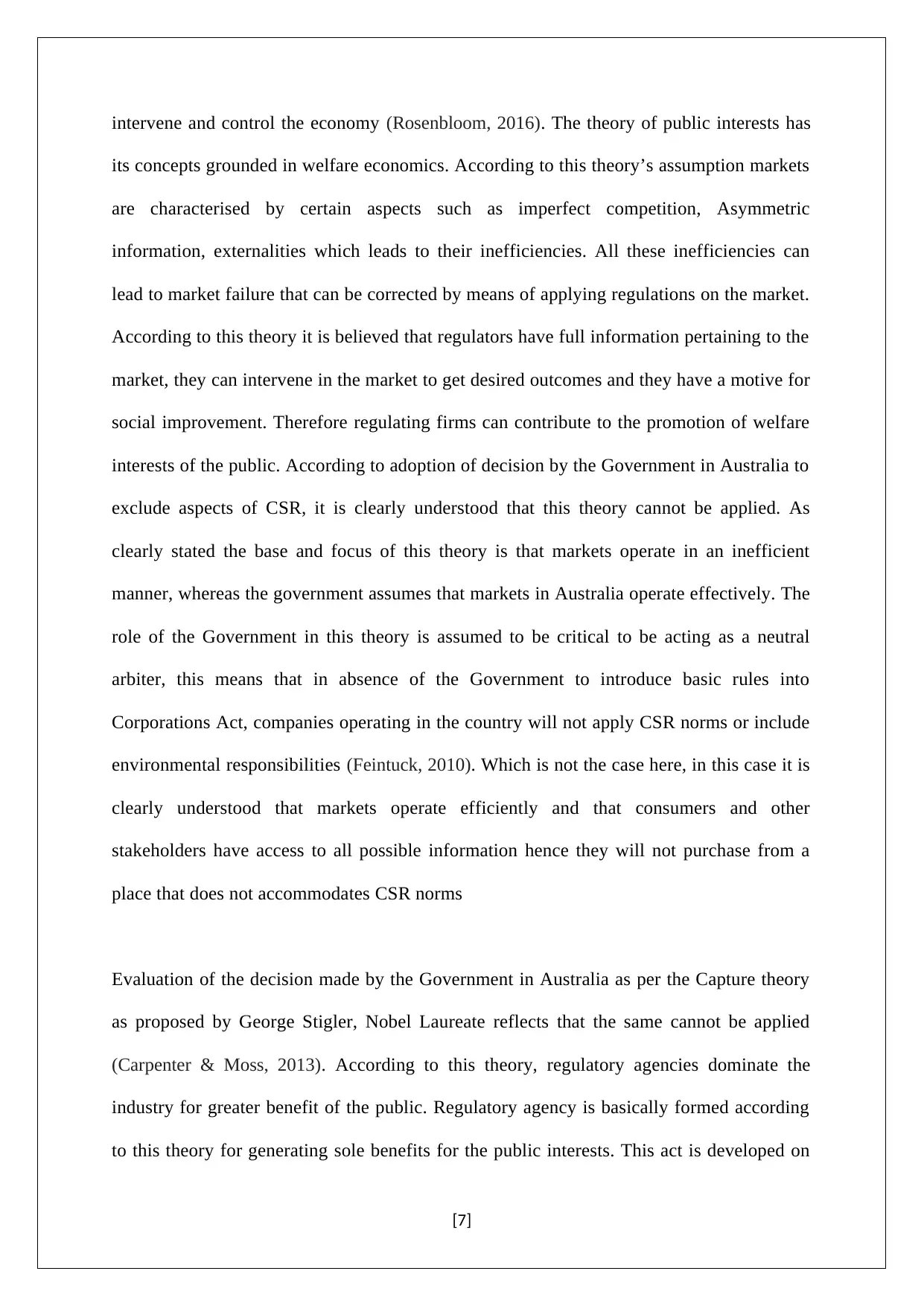
intervene and control the economy (Rosenbloom, 2016). The theory of public interests has
its concepts grounded in welfare economics. According to this theory’s assumption markets
are characterised by certain aspects such as imperfect competition, Asymmetric
information, externalities which leads to their inefficiencies. All these inefficiencies can
lead to market failure that can be corrected by means of applying regulations on the market.
According to this theory it is believed that regulators have full information pertaining to the
market, they can intervene in the market to get desired outcomes and they have a motive for
social improvement. Therefore regulating firms can contribute to the promotion of welfare
interests of the public. According to adoption of decision by the Government in Australia to
exclude aspects of CSR, it is clearly understood that this theory cannot be applied. As
clearly stated the base and focus of this theory is that markets operate in an inefficient
manner, whereas the government assumes that markets in Australia operate effectively. The
role of the Government in this theory is assumed to be critical to be acting as a neutral
arbiter, this means that in absence of the Government to introduce basic rules into
Corporations Act, companies operating in the country will not apply CSR norms or include
environmental responsibilities (Feintuck, 2010). Which is not the case here, in this case it is
clearly understood that markets operate efficiently and that consumers and other
stakeholders have access to all possible information hence they will not purchase from a
place that does not accommodates CSR norms
Evaluation of the decision made by the Government in Australia as per the Capture theory
as proposed by George Stigler, Nobel Laureate reflects that the same cannot be applied
(Carpenter & Moss, 2013). According to this theory, regulatory agencies dominate the
industry for greater benefit of the public. Regulatory agency is basically formed according
to this theory for generating sole benefits for the public interests. This act is developed on
[7]
its concepts grounded in welfare economics. According to this theory’s assumption markets
are characterised by certain aspects such as imperfect competition, Asymmetric
information, externalities which leads to their inefficiencies. All these inefficiencies can
lead to market failure that can be corrected by means of applying regulations on the market.
According to this theory it is believed that regulators have full information pertaining to the
market, they can intervene in the market to get desired outcomes and they have a motive for
social improvement. Therefore regulating firms can contribute to the promotion of welfare
interests of the public. According to adoption of decision by the Government in Australia to
exclude aspects of CSR, it is clearly understood that this theory cannot be applied. As
clearly stated the base and focus of this theory is that markets operate in an inefficient
manner, whereas the government assumes that markets in Australia operate effectively. The
role of the Government in this theory is assumed to be critical to be acting as a neutral
arbiter, this means that in absence of the Government to introduce basic rules into
Corporations Act, companies operating in the country will not apply CSR norms or include
environmental responsibilities (Feintuck, 2010). Which is not the case here, in this case it is
clearly understood that markets operate efficiently and that consumers and other
stakeholders have access to all possible information hence they will not purchase from a
place that does not accommodates CSR norms
Evaluation of the decision made by the Government in Australia as per the Capture theory
as proposed by George Stigler, Nobel Laureate reflects that the same cannot be applied
(Carpenter & Moss, 2013). According to this theory, regulatory agencies dominate the
industry for greater benefit of the public. Regulatory agency is basically formed according
to this theory for generating sole benefits for the public interests. This act is developed on
[7]
Paraphrase This Document
Need a fresh take? Get an instant paraphrase of this document with our AI Paraphraser
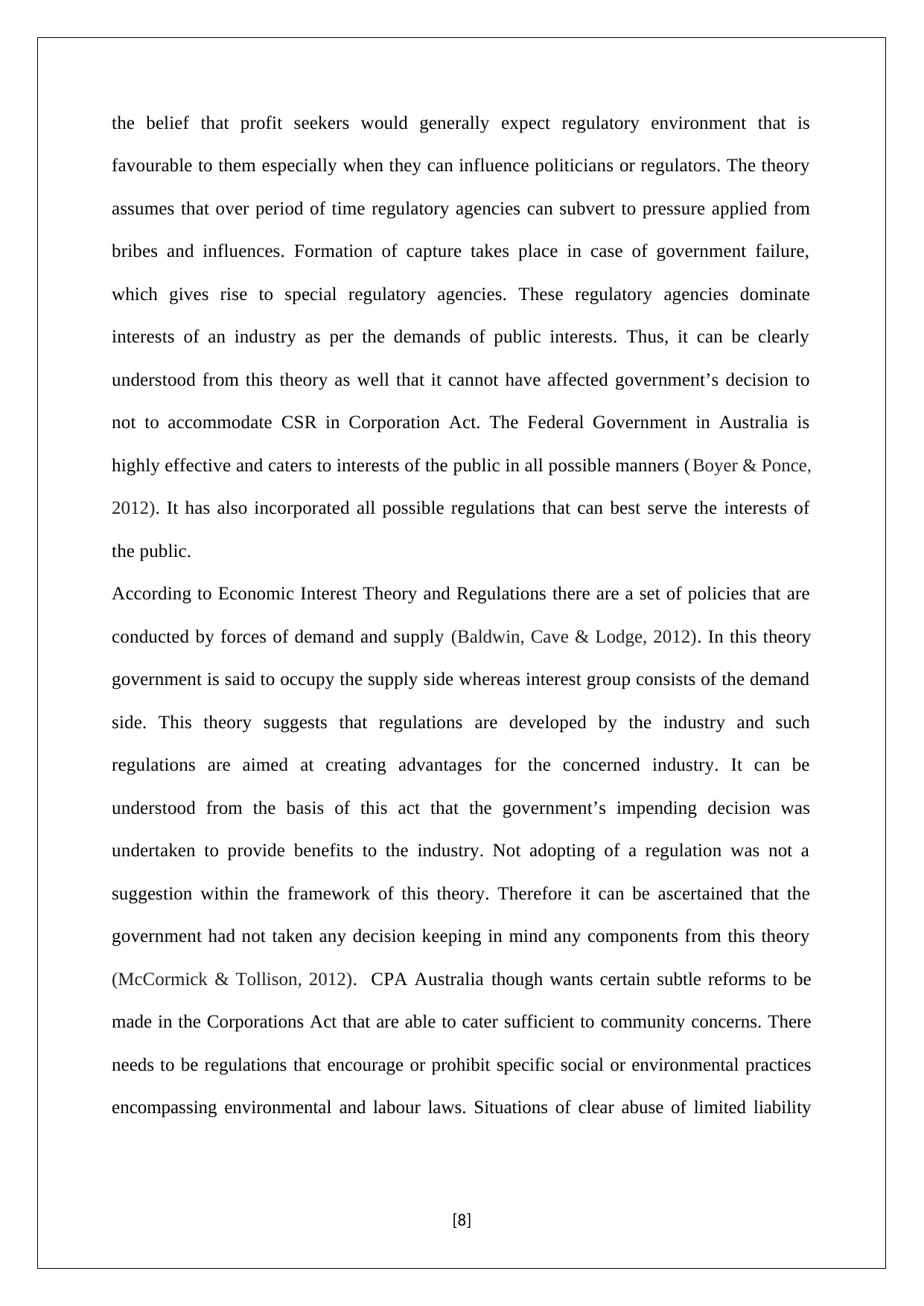
the belief that profit seekers would generally expect regulatory environment that is
favourable to them especially when they can influence politicians or regulators. The theory
assumes that over period of time regulatory agencies can subvert to pressure applied from
bribes and influences. Formation of capture takes place in case of government failure,
which gives rise to special regulatory agencies. These regulatory agencies dominate
interests of an industry as per the demands of public interests. Thus, it can be clearly
understood from this theory as well that it cannot have affected government’s decision to
not to accommodate CSR in Corporation Act. The Federal Government in Australia is
highly effective and caters to interests of the public in all possible manners ( Boyer & Ponce,
2012). It has also incorporated all possible regulations that can best serve the interests of
the public.
According to Economic Interest Theory and Regulations there are a set of policies that are
conducted by forces of demand and supply (Baldwin, Cave & Lodge, 2012). In this theory
government is said to occupy the supply side whereas interest group consists of the demand
side. This theory suggests that regulations are developed by the industry and such
regulations are aimed at creating advantages for the concerned industry. It can be
understood from the basis of this act that the government’s impending decision was
undertaken to provide benefits to the industry. Not adopting of a regulation was not a
suggestion within the framework of this theory. Therefore it can be ascertained that the
government had not taken any decision keeping in mind any components from this theory
(McCormick & Tollison, 2012). CPA Australia though wants certain subtle reforms to be
made in the Corporations Act that are able to cater sufficient to community concerns. There
needs to be regulations that encourage or prohibit specific social or environmental practices
encompassing environmental and labour laws. Situations of clear abuse of limited liability
[8]
favourable to them especially when they can influence politicians or regulators. The theory
assumes that over period of time regulatory agencies can subvert to pressure applied from
bribes and influences. Formation of capture takes place in case of government failure,
which gives rise to special regulatory agencies. These regulatory agencies dominate
interests of an industry as per the demands of public interests. Thus, it can be clearly
understood from this theory as well that it cannot have affected government’s decision to
not to accommodate CSR in Corporation Act. The Federal Government in Australia is
highly effective and caters to interests of the public in all possible manners ( Boyer & Ponce,
2012). It has also incorporated all possible regulations that can best serve the interests of
the public.
According to Economic Interest Theory and Regulations there are a set of policies that are
conducted by forces of demand and supply (Baldwin, Cave & Lodge, 2012). In this theory
government is said to occupy the supply side whereas interest group consists of the demand
side. This theory suggests that regulations are developed by the industry and such
regulations are aimed at creating advantages for the concerned industry. It can be
understood from the basis of this act that the government’s impending decision was
undertaken to provide benefits to the industry. Not adopting of a regulation was not a
suggestion within the framework of this theory. Therefore it can be ascertained that the
government had not taken any decision keeping in mind any components from this theory
(McCormick & Tollison, 2012). CPA Australia though wants certain subtle reforms to be
made in the Corporations Act that are able to cater sufficient to community concerns. There
needs to be regulations that encourage or prohibit specific social or environmental practices
encompassing environmental and labour laws. Situations of clear abuse of limited liability
[8]
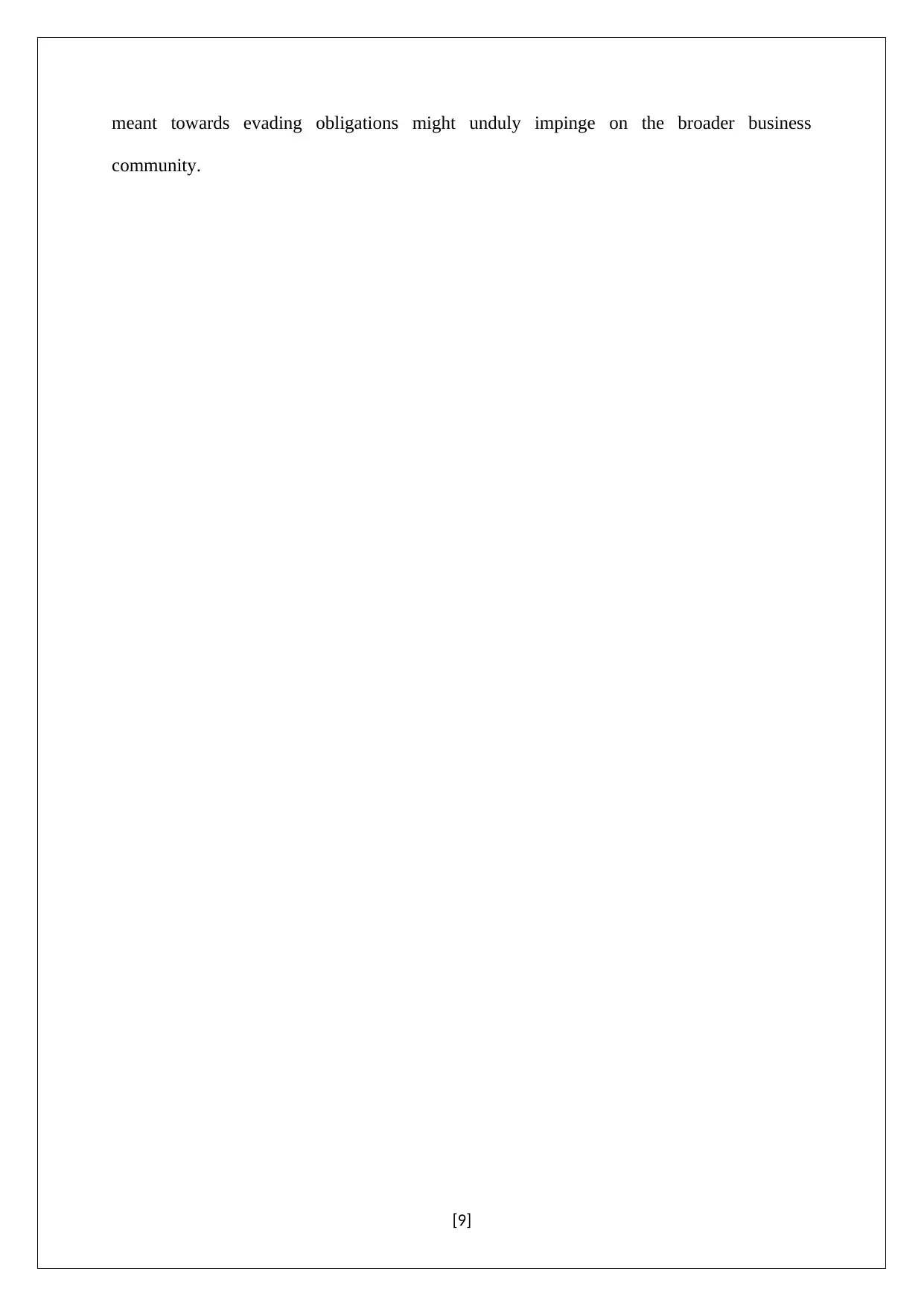
meant towards evading obligations might unduly impinge on the broader business
community.
[9]
community.
[9]
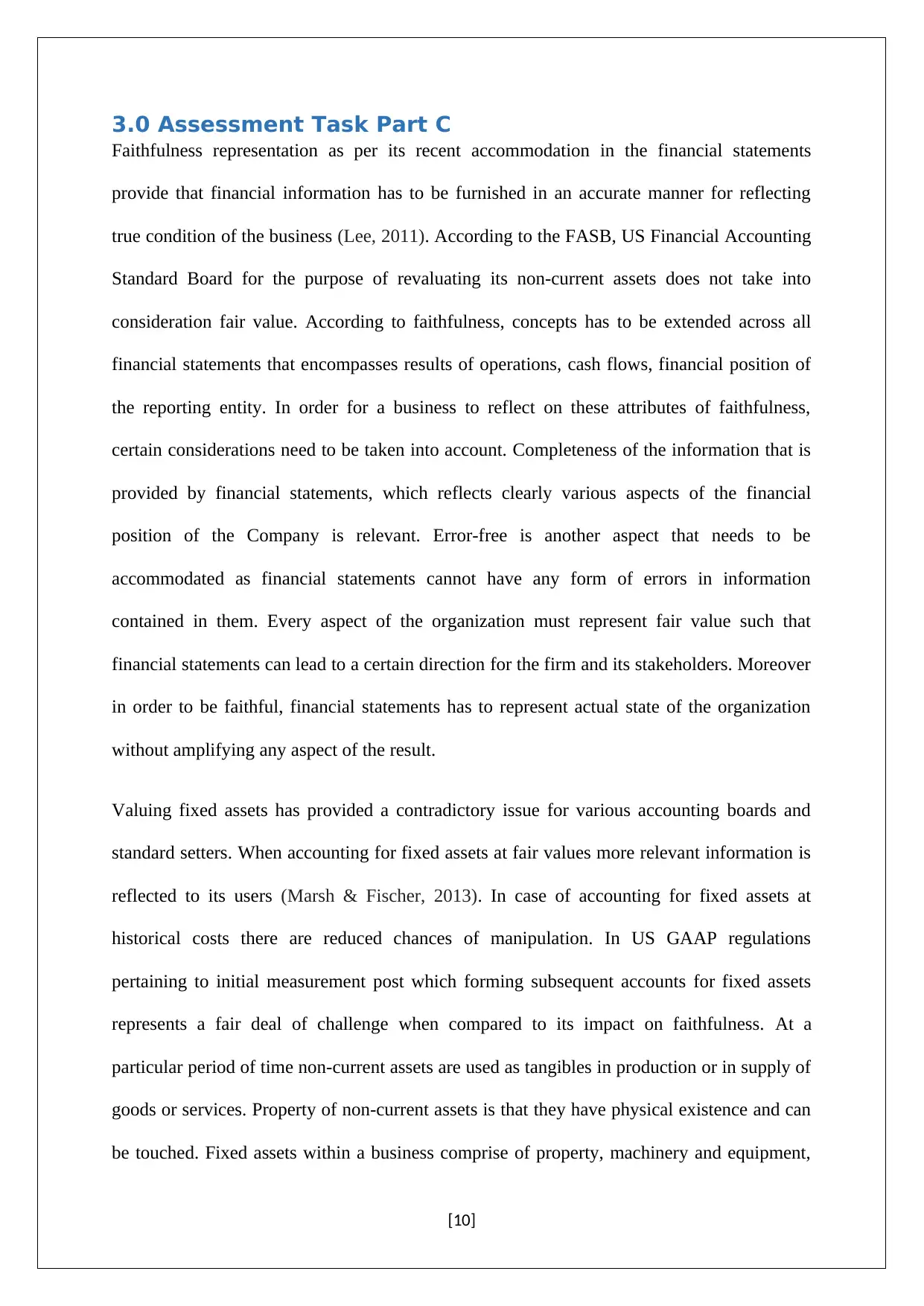
3.0 Assessment Task Part C
Faithfulness representation as per its recent accommodation in the financial statements
provide that financial information has to be furnished in an accurate manner for reflecting
true condition of the business (Lee, 2011). According to the FASB, US Financial Accounting
Standard Board for the purpose of revaluating its non-current assets does not take into
consideration fair value. According to faithfulness, concepts has to be extended across all
financial statements that encompasses results of operations, cash flows, financial position of
the reporting entity. In order for a business to reflect on these attributes of faithfulness,
certain considerations need to be taken into account. Completeness of the information that is
provided by financial statements, which reflects clearly various aspects of the financial
position of the Company is relevant. Error-free is another aspect that needs to be
accommodated as financial statements cannot have any form of errors in information
contained in them. Every aspect of the organization must represent fair value such that
financial statements can lead to a certain direction for the firm and its stakeholders. Moreover
in order to be faithful, financial statements has to represent actual state of the organization
without amplifying any aspect of the result.
Valuing fixed assets has provided a contradictory issue for various accounting boards and
standard setters. When accounting for fixed assets at fair values more relevant information is
reflected to its users (Marsh & Fischer, 2013). In case of accounting for fixed assets at
historical costs there are reduced chances of manipulation. In US GAAP regulations
pertaining to initial measurement post which forming subsequent accounts for fixed assets
represents a fair deal of challenge when compared to its impact on faithfulness. At a
particular period of time non-current assets are used as tangibles in production or in supply of
goods or services. Property of non-current assets is that they have physical existence and can
be touched. Fixed assets within a business comprise of property, machinery and equipment,
[10]
Faithfulness representation as per its recent accommodation in the financial statements
provide that financial information has to be furnished in an accurate manner for reflecting
true condition of the business (Lee, 2011). According to the FASB, US Financial Accounting
Standard Board for the purpose of revaluating its non-current assets does not take into
consideration fair value. According to faithfulness, concepts has to be extended across all
financial statements that encompasses results of operations, cash flows, financial position of
the reporting entity. In order for a business to reflect on these attributes of faithfulness,
certain considerations need to be taken into account. Completeness of the information that is
provided by financial statements, which reflects clearly various aspects of the financial
position of the Company is relevant. Error-free is another aspect that needs to be
accommodated as financial statements cannot have any form of errors in information
contained in them. Every aspect of the organization must represent fair value such that
financial statements can lead to a certain direction for the firm and its stakeholders. Moreover
in order to be faithful, financial statements has to represent actual state of the organization
without amplifying any aspect of the result.
Valuing fixed assets has provided a contradictory issue for various accounting boards and
standard setters. When accounting for fixed assets at fair values more relevant information is
reflected to its users (Marsh & Fischer, 2013). In case of accounting for fixed assets at
historical costs there are reduced chances of manipulation. In US GAAP regulations
pertaining to initial measurement post which forming subsequent accounts for fixed assets
represents a fair deal of challenge when compared to its impact on faithfulness. At a
particular period of time non-current assets are used as tangibles in production or in supply of
goods or services. Property of non-current assets is that they have physical existence and can
be touched. Fixed assets within a business comprise of property, machinery and equipment,
[10]
Secure Best Marks with AI Grader
Need help grading? Try our AI Grader for instant feedback on your assignments.

plant and equipment typically consist of land, buildings, as well as furniture and fixtures. As
per US GAAP regulations, all non-current assets are accounted for using the historical cost
model, which stipulates that non-current assets are initially recorded at cost. Post which they
are treated at cost less accumulated depreciation and cumulative impairment losses. Generally
any changing circumstances which can lead to upward adjustments are avoided. It often leads
an impact that the condition of the organization is far worse than it actually is or far better. As
depreciation is set aside creating a provision for the non-current assets, profits might be
reflected which are not real in nature. Therefore it is an impact on the faithfulness of the
financial statement.
According to FASB Statement No. 144 Accounting for the Impairment or Disposal of Long-
Lived Assets, the cost model allows impairment losses to be adjusted in a downward manner
(Barua, Lin & Sbaraglia, 2010). In this case long-lived assets are tested for impairment in
case there is an indication that their carrying amount exceeds their market value. The adjusted
carrying amount of a fixed asset becomes its new cost, in case an impairment loss is
recognized. This loss is depreciated over the remaining useful life of that asset. The
regulation prohibits restoration of a previously recognized impairment loss. This is again a
procedure where true value for an asset might not get recognised. Profits or losses which are
actual will not get reflected through this manner. This might lead to biasness creeping within
the financial statements.
[11]
per US GAAP regulations, all non-current assets are accounted for using the historical cost
model, which stipulates that non-current assets are initially recorded at cost. Post which they
are treated at cost less accumulated depreciation and cumulative impairment losses. Generally
any changing circumstances which can lead to upward adjustments are avoided. It often leads
an impact that the condition of the organization is far worse than it actually is or far better. As
depreciation is set aside creating a provision for the non-current assets, profits might be
reflected which are not real in nature. Therefore it is an impact on the faithfulness of the
financial statement.
According to FASB Statement No. 144 Accounting for the Impairment or Disposal of Long-
Lived Assets, the cost model allows impairment losses to be adjusted in a downward manner
(Barua, Lin & Sbaraglia, 2010). In this case long-lived assets are tested for impairment in
case there is an indication that their carrying amount exceeds their market value. The adjusted
carrying amount of a fixed asset becomes its new cost, in case an impairment loss is
recognized. This loss is depreciated over the remaining useful life of that asset. The
regulation prohibits restoration of a previously recognized impairment loss. This is again a
procedure where true value for an asset might not get recognised. Profits or losses which are
actual will not get reflected through this manner. This might lead to biasness creeping within
the financial statements.
[11]

4.0 Assessment Task Part D
(a)What might motivate directors not to revalue the property, plant and equipment?
Directors of several companies might not want to revalue their property, plant and equipment
at fair value. Most organization prefer using historical cost model in which assets that are
listed in financial statements of the company often gets recorded at the price at which they are
purchased (Damodaran, 2012). According to US GAAP historical cost principle implies
recording of an asset at a price for the amount of which capital has been spent on it. It makes
use of the Company’s past transaction hence is considered a reliable and conservative method
used for the purpose of calculating cost of an asset. This model sums up to lower costs of
assets and lower measurement which further leads to lower backing of shares. Therefore, in
order to not reflect fair value of assets and furnish complete picture of a firm’s financial
position these methods is often used.
(b)What are some of the effects the decision not to revalue might have on the firm’s financial
statements?
In case the directors and financial heads of the company ascertains not to revalue assets of the
Company at an appropriate price, then the financial statement will not reflect true picture for
the firm (Christensen & Nikolaev, 2013). The firm’s financial information will not be faithful
in nature. Meaning that the values furnished cannot be depended upon or reliable that can be
used by investors or shareholders for the purpose of making their financial judgements.
(c)Would the decision not to revalue adversely affect the wealth of the shareholders?
[12]
(a)What might motivate directors not to revalue the property, plant and equipment?
Directors of several companies might not want to revalue their property, plant and equipment
at fair value. Most organization prefer using historical cost model in which assets that are
listed in financial statements of the company often gets recorded at the price at which they are
purchased (Damodaran, 2012). According to US GAAP historical cost principle implies
recording of an asset at a price for the amount of which capital has been spent on it. It makes
use of the Company’s past transaction hence is considered a reliable and conservative method
used for the purpose of calculating cost of an asset. This model sums up to lower costs of
assets and lower measurement which further leads to lower backing of shares. Therefore, in
order to not reflect fair value of assets and furnish complete picture of a firm’s financial
position these methods is often used.
(b)What are some of the effects the decision not to revalue might have on the firm’s financial
statements?
In case the directors and financial heads of the company ascertains not to revalue assets of the
Company at an appropriate price, then the financial statement will not reflect true picture for
the firm (Christensen & Nikolaev, 2013). The firm’s financial information will not be faithful
in nature. Meaning that the values furnished cannot be depended upon or reliable that can be
used by investors or shareholders for the purpose of making their financial judgements.
(c)Would the decision not to revalue adversely affect the wealth of the shareholders?
[12]

The decision not to revalue assets as per fair value can adversely affect the wealth of the
shareholders (Power, 2010). As depreciation and other aspects will not be charged to the
asset, reflection of backing of shares will be limited. In case of liquidation, the shareholders
will be able to raise fewer claims as opposed to real picture depicted by the Company. Unfair
financial statements will be provided by the company that does not indicate true financial
information.
[13]
shareholders (Power, 2010). As depreciation and other aspects will not be charged to the
asset, reflection of backing of shares will be limited. In case of liquidation, the shareholders
will be able to raise fewer claims as opposed to real picture depicted by the Company. Unfair
financial statements will be provided by the company that does not indicate true financial
information.
[13]
Paraphrase This Document
Need a fresh take? Get an instant paraphrase of this document with our AI Paraphraser
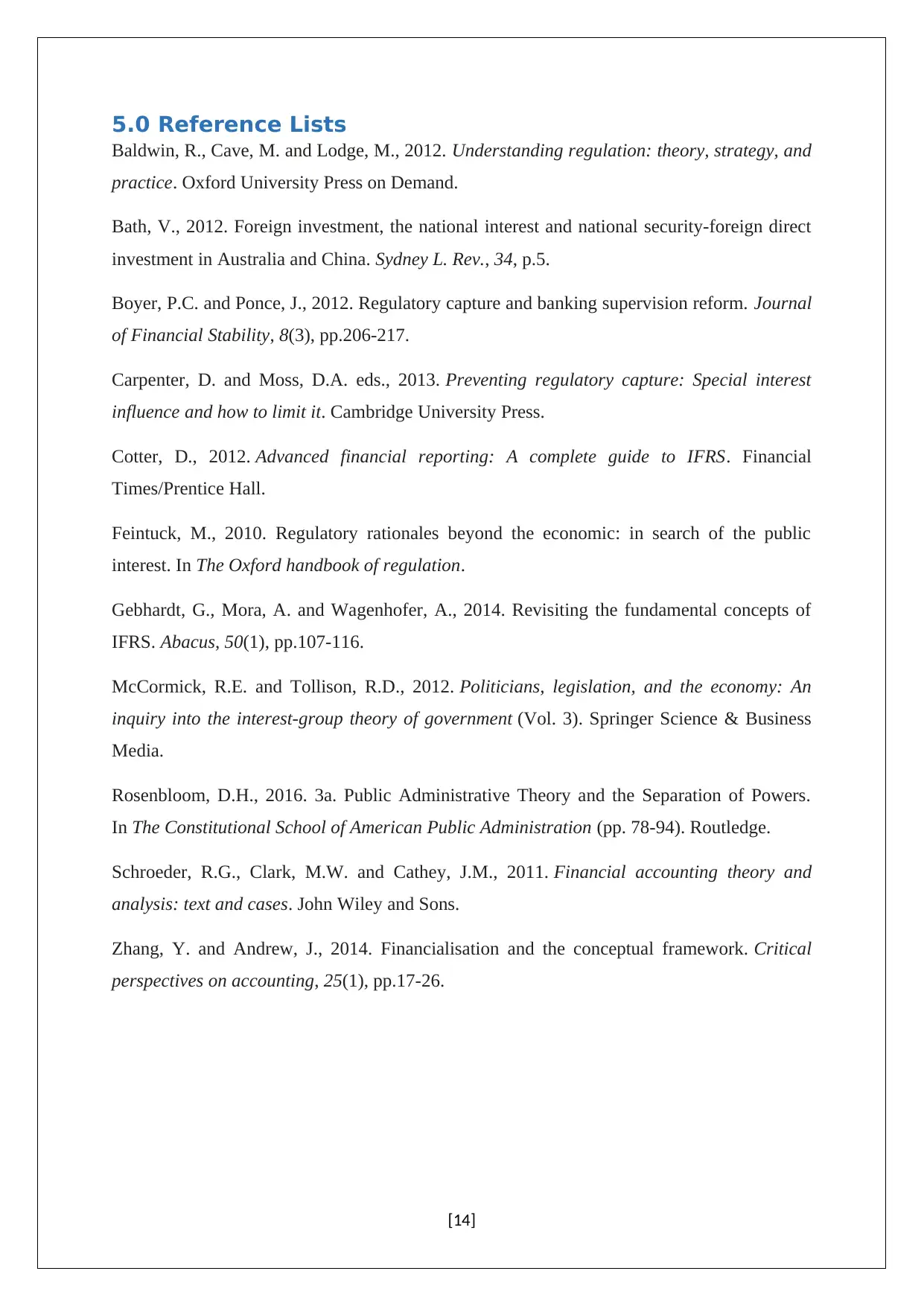
5.0 Reference Lists
Baldwin, R., Cave, M. and Lodge, M., 2012. Understanding regulation: theory, strategy, and
practice. Oxford University Press on Demand.
Bath, V., 2012. Foreign investment, the national interest and national security-foreign direct
investment in Australia and China. Sydney L. Rev., 34, p.5.
Boyer, P.C. and Ponce, J., 2012. Regulatory capture and banking supervision reform. Journal
of Financial Stability, 8(3), pp.206-217.
Carpenter, D. and Moss, D.A. eds., 2013. Preventing regulatory capture: Special interest
influence and how to limit it. Cambridge University Press.
Cotter, D., 2012. Advanced financial reporting: A complete guide to IFRS. Financial
Times/Prentice Hall.
Feintuck, M., 2010. Regulatory rationales beyond the economic: in search of the public
interest. In The Oxford handbook of regulation.
Gebhardt, G., Mora, A. and Wagenhofer, A., 2014. Revisiting the fundamental concepts of
IFRS. Abacus, 50(1), pp.107-116.
McCormick, R.E. and Tollison, R.D., 2012. Politicians, legislation, and the economy: An
inquiry into the interest-group theory of government (Vol. 3). Springer Science & Business
Media.
Rosenbloom, D.H., 2016. 3a. Public Administrative Theory and the Separation of Powers.
In The Constitutional School of American Public Administration (pp. 78-94). Routledge.
Schroeder, R.G., Clark, M.W. and Cathey, J.M., 2011. Financial accounting theory and
analysis: text and cases. John Wiley and Sons.
Zhang, Y. and Andrew, J., 2014. Financialisation and the conceptual framework. Critical
perspectives on accounting, 25(1), pp.17-26.
[14]
Baldwin, R., Cave, M. and Lodge, M., 2012. Understanding regulation: theory, strategy, and
practice. Oxford University Press on Demand.
Bath, V., 2012. Foreign investment, the national interest and national security-foreign direct
investment in Australia and China. Sydney L. Rev., 34, p.5.
Boyer, P.C. and Ponce, J., 2012. Regulatory capture and banking supervision reform. Journal
of Financial Stability, 8(3), pp.206-217.
Carpenter, D. and Moss, D.A. eds., 2013. Preventing regulatory capture: Special interest
influence and how to limit it. Cambridge University Press.
Cotter, D., 2012. Advanced financial reporting: A complete guide to IFRS. Financial
Times/Prentice Hall.
Feintuck, M., 2010. Regulatory rationales beyond the economic: in search of the public
interest. In The Oxford handbook of regulation.
Gebhardt, G., Mora, A. and Wagenhofer, A., 2014. Revisiting the fundamental concepts of
IFRS. Abacus, 50(1), pp.107-116.
McCormick, R.E. and Tollison, R.D., 2012. Politicians, legislation, and the economy: An
inquiry into the interest-group theory of government (Vol. 3). Springer Science & Business
Media.
Rosenbloom, D.H., 2016. 3a. Public Administrative Theory and the Separation of Powers.
In The Constitutional School of American Public Administration (pp. 78-94). Routledge.
Schroeder, R.G., Clark, M.W. and Cathey, J.M., 2011. Financial accounting theory and
analysis: text and cases. John Wiley and Sons.
Zhang, Y. and Andrew, J., 2014. Financialisation and the conceptual framework. Critical
perspectives on accounting, 25(1), pp.17-26.
[14]
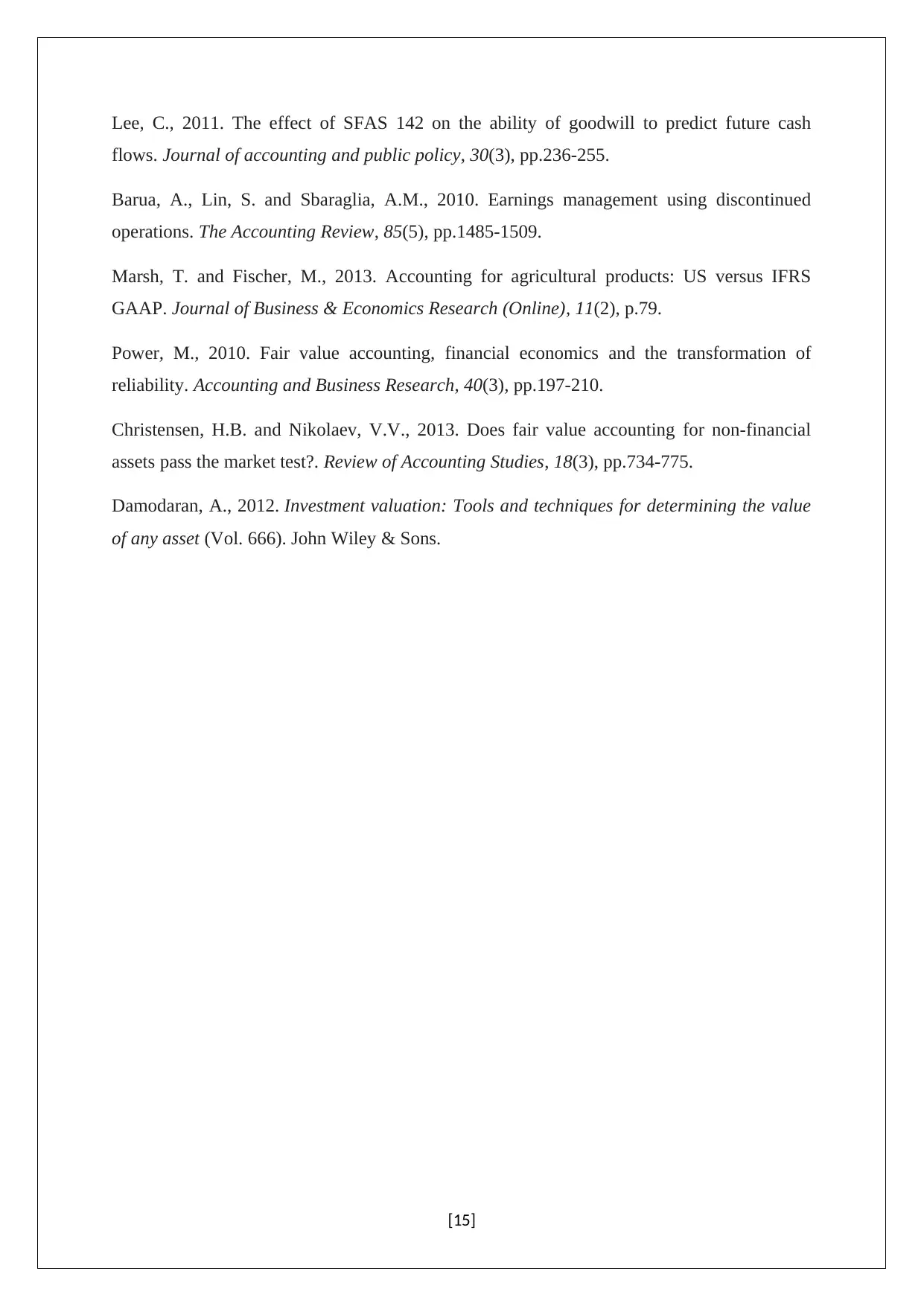
Lee, C., 2011. The effect of SFAS 142 on the ability of goodwill to predict future cash
flows. Journal of accounting and public policy, 30(3), pp.236-255.
Barua, A., Lin, S. and Sbaraglia, A.M., 2010. Earnings management using discontinued
operations. The Accounting Review, 85(5), pp.1485-1509.
Marsh, T. and Fischer, M., 2013. Accounting for agricultural products: US versus IFRS
GAAP. Journal of Business & Economics Research (Online), 11(2), p.79.
Power, M., 2010. Fair value accounting, financial economics and the transformation of
reliability. Accounting and Business Research, 40(3), pp.197-210.
Christensen, H.B. and Nikolaev, V.V., 2013. Does fair value accounting for non-financial
assets pass the market test?. Review of Accounting Studies, 18(3), pp.734-775.
Damodaran, A., 2012. Investment valuation: Tools and techniques for determining the value
of any asset (Vol. 666). John Wiley & Sons.
[15]
flows. Journal of accounting and public policy, 30(3), pp.236-255.
Barua, A., Lin, S. and Sbaraglia, A.M., 2010. Earnings management using discontinued
operations. The Accounting Review, 85(5), pp.1485-1509.
Marsh, T. and Fischer, M., 2013. Accounting for agricultural products: US versus IFRS
GAAP. Journal of Business & Economics Research (Online), 11(2), p.79.
Power, M., 2010. Fair value accounting, financial economics and the transformation of
reliability. Accounting and Business Research, 40(3), pp.197-210.
Christensen, H.B. and Nikolaev, V.V., 2013. Does fair value accounting for non-financial
assets pass the market test?. Review of Accounting Studies, 18(3), pp.734-775.
Damodaran, A., 2012. Investment valuation: Tools and techniques for determining the value
of any asset (Vol. 666). John Wiley & Sons.
[15]
1 out of 15
Related Documents
Your All-in-One AI-Powered Toolkit for Academic Success.
+13062052269
info@desklib.com
Available 24*7 on WhatsApp / Email
![[object Object]](/_next/static/media/star-bottom.7253800d.svg)
Unlock your academic potential
© 2024 | Zucol Services PVT LTD | All rights reserved.





